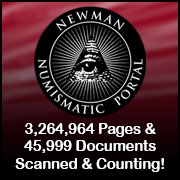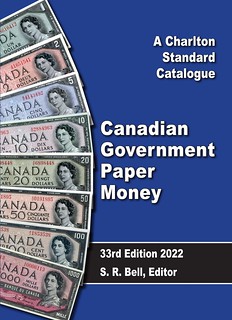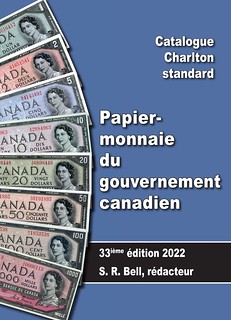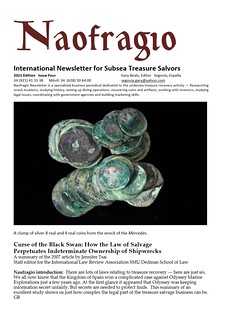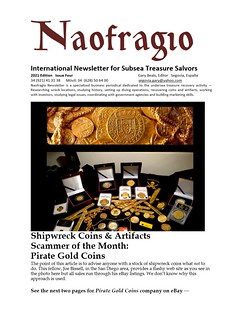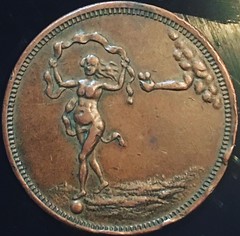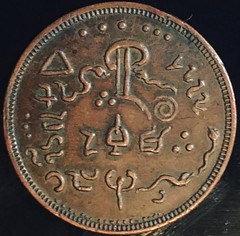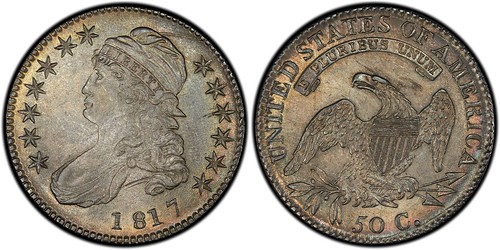
Visit our NBS Sponsors


|
About Us
The Numismatic Bibliomania Society is a non-profit association devoted to the study and enjoyment of numismatic literature. For more information please see our web site at coinbooks.org SubscriptionsThose wishing to become new E-Sylum subscribers (or wishing to Unsubscribe) can go to the following web page link MembershipThere is a membership application available on the web site Membership Application To join, print the application and return it with your check to the address printed on the application. Print/Digital membership is $40 to addresses in the U.S., and $60 elsewhere. A digital-only membership is available for $25. For those without web access, write to: Charles Heck, Treasurer AsylumFor Asylum mailing address changes and other membership questions, contact Chuck at this email address: treasurer@coinbooks.org SubmissionsTo submit items for publication in The E-Sylum, write to the Editor at this address: whomren@gmail.com BUY THE BOOK BEFORE THE COINSale Calendar |
- WAYNE'S WORDS: THE E-SYLUM APRIL 18, 2021
- NEW BOOK: A PENNY SAVED
- NEW BOOK: STRIKING GOLD IN ALASKA, 7TH EDITION
- NEW BOOK: CANADIAN GOVERNMENT PAPER MONEY
- NEW PERIODICAL: THE NAOFRAGIO NEWSLETTER
- ARTICLE: COIN WEAR
- BOOK REVIEW: CONFIDENT CARSON CITY COLLECTOR
- BOOK REVIEW: GUIDE BOOK OF U.S. PAPER MONEY
- GLENDINING AUCTION SALE CATALOGS ON NNP
- VIDEO: PAPER MONEY AT COLLECTORAMA 2021
- THE MYSTERIOUS WHITEHEAD & HOAG TOKEN
- MORE ON DIE VARIETIES
- WARREN & SON, SACRAMENTO
- NOTES FROM E-SYLUM READERS: APRIL 18, 2021
- VOCABULARY TERM: DIE STAMPED, DIE STRUCK
- JOHN HENRY MATTHEWS (1808-1870)
- B. MAX MEHL, FORT WORTH MARKETING WHIZ
- NEW NLG EXECUTIVE DIRECTOR CHARLES MORGAN
- THE NUMISMATIC LITERARY GUILD MISSION
- ICTA REBRANDS AS NATIONAL COIN & BULLION
- MPC FEST XXII/2021 REPORT
- ARCHIVES INTERNATIONAL AUCTION 66
- SOVEREIGN RARITIES LONDON AUCTION 3
- NUMISMATIC NUGGETS: APRIL 18, 2021
- LORD ST. OSWALD 1794 HALF CENT REAPPEARS
- 2021 AMSA MEDAL OF THE YEAR WINNERS
- 2020 IBNS BANK NOTE OF YEAR AWARD
- MAGNET FISHERS FIND SAFE WITH STOLEN COINS
- OLD BUILDING YIELDS GOLD HOARD
- LOOSE CHANGE: APRIL 18, 2021
Click here to read the thin version on the web
Click here to subscribe
Click here to access the complete archive
To comment or submit articles, reply to whomren@gmail.com
Content presented in The E-Sylum is not necessarily researched or independently fact-checked, and views expressed do not necessarily represent those of the Numismatic Bibliomania Society.
WAYNE'S WORDS: THE E-SYLUM APRIL 18, 2021
 New subscribers this week include:
Robert Staub, courtesy Ken Bressett;
Greg Cheek, and
Alberto Maia.
Welcome aboard! We now have 6,641 subscribers.
New subscribers this week include:
Robert Staub, courtesy Ken Bressett;
Greg Cheek, and
Alberto Maia.
Welcome aboard! We now have 6,641 subscribers.
Thank you for reading The E-Sylum. If you enjoy it, please send me the email addresses of friends you think may enjoy it as well and I'll send them a subscription. Contact me at whomren@gmail.com anytime regarding your subscription, or questions, comments or suggestions about our content.
This week we open with three new books, a new periodical, two reviews, updates from the Newman Numismatic Portal, and more.
Other topics this week include the Red Book, B. Max Mehl, the Numismatic Literary Guild, MPC Fest, auction previews, and annual award winners, including the Banknote of the Year.
To learn more about placer gold tokens, Canadian paper money, treasure salvage, coin wear, Carson City coinage, Fortuna, Charles Morgan, Lee Martin, the morality police, magnet fishing, the George Floyd medal, and the Westminster Abbey Gold Medal, read on. Have a great week, everyone!
Wayne Homren
Editor, The E-Sylum

NEW BOOK: A PENNY SAVED
Here's a new book for coin collectors and numismatic bibliophiles alike - Ken Bressett's book on R. S. Yeoman and the ubiquitous Red Book. -Editor
A Penny Saved: R.S. Yeoman and His Remarkable Red Book
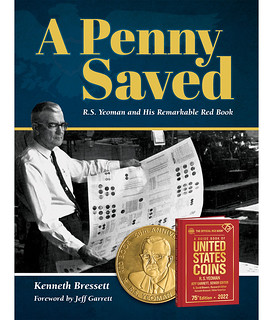 Whitman Publishing announces the upcoming release of A Penny Saved: R.S. Yeoman and His Remarkable Red Book, by Kenneth Bressett. The 352-page hardcover volume will debut in summer 2021, available from booksellers and hobby shops nationwide. In the meantime, it is available for preorder (including at www.Whitman.com and online bookstores).
Whitman Publishing announces the upcoming release of A Penny Saved: R.S. Yeoman and His Remarkable Red Book, by Kenneth Bressett. The 352-page hardcover volume will debut in summer 2021, available from booksellers and hobby shops nationwide. In the meantime, it is available for preorder (including at www.Whitman.com and online bookstores).
The hobby's popular “Red Book"—officially titled A Guide Book of United States Coins—is celebrating its 75th edition this year. In A Penny Saved, the Red Book's editor emeritus, Kenneth Bressett, presents a history of the groundbreaking book and a biography of author R.S. Yeoman, who helped ignite a boom in coin-collecting starting in the 1930s and 1940s by promoting innovations including coin boards, folders, and new books. He tells the story of publishing giant Western Printing & Lithographing Company and follows the development of its offshoot, Whitman Publishing, from 1916 to today. Bressett, who worked alongside Yeoman, also shares his own life story in and out of numismatics. Both men have left indelible imprints on the hobby and on publishing in the United States.

NEW BOOK: STRIKING GOLD IN ALASKA, 7TH EDITION
Dick Hanscom of Alaska Rare Coins has published a new edition of his book on the nuts and bolts of making tokens from placer gold. For more information, contact Dick at akcoins@mosquitonet.com . -Editor
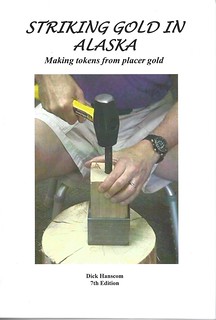 I am pleased to announce the publication of the 7th edition of my book "Striking Gold in Alaska, Making tokens from placer gold."
I am pleased to announce the publication of the 7th edition of my book "Striking Gold in Alaska, Making tokens from placer gold."
Why another edition? Well, the 6th edition is nearly sold out, and because I can.
However, there is new information in this edition. The 6th edition was 221 pages, while the new 7th edition is 258 pages.
There are new techniques and improved techniques. There are even new procedures for new products.
It tells you what I have been up to since 2017 - two trips to England (why is that in there?), Russian wire money, new silver products and other adventures in minting.
NEW BOOK: CANADIAN GOVERNMENT PAPER MONEY
There's a new edition of the Charlton Standard Catalogue of Canadian Government Paper Money available in both English and French versions. Here's information from the Trajan Media coin and stamp supplies site. -Editor

NEW PERIODICAL: THE NAOFRAGIO NEWSLETTER
Gary Beals of Segovia Spain recently launched a new publication on shipwreck coins. Naofragio is an international newsletter for subsea treasure salvors. He provided this great introduction for E-Sylum readers. Thanks! -Editor
as we enter the golden age of shipwreck recovery
Thousands of coins are missing from our collections. And hundreds of tons of gold coins, and thousands of tons of silver coins will be recovered from the world's oceans in the next few years. The result should be more affordable scarce coins, each with a fascinating story to tell of its journey from a sunken galleon into a collector's hands. Simple ‘supply and demand' theories about what will occur in the years ahead is not the answer. Could the huge addition of coins create thousands of type set collectors of Colonial Spanish American coins?
Some of the coins collectors are missing in their collections are on the bottom of the world's oceans. Storms, earthquakes, crime, navigational errors, and explosions aboard ships over the last four centuries caused this. That historical treasure turns out to be billions of dollars worth of gold and silver coins hidden under sand, mud and coral heads.
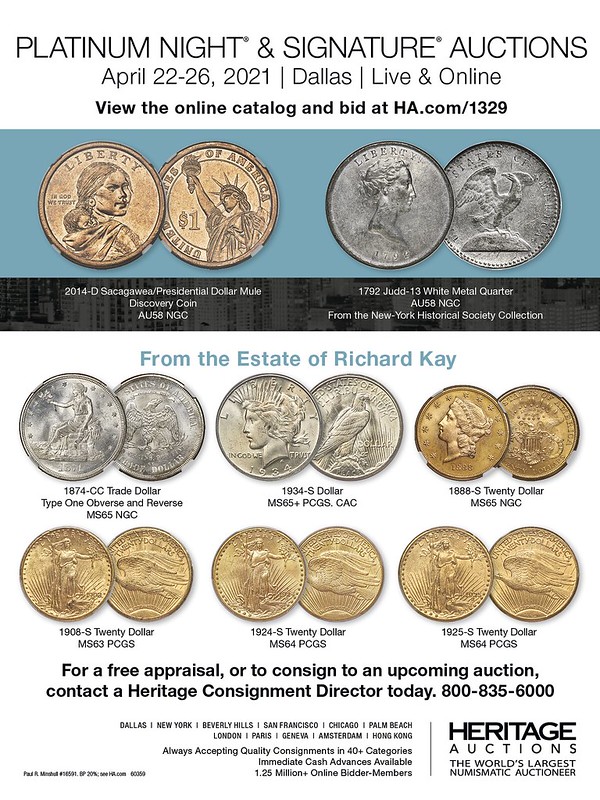
ARTICLE: COIN WEAR
Economist, author and E-Sylum contributor François R. Velde co-authored a new paper in the journal Physica A: Statistical Mechanics and its Applications titled Coin wear: A power law for small shocks. Interesting for those of us who geek out on both coins and math. -Editor
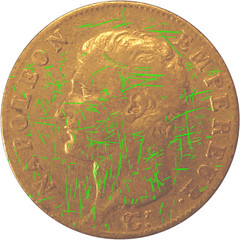 Abstract
Abstract
The study of coin wear is useful for numismatics and economics. We examine a 19th century gold coin with a SEM and show that weight loss is due to a large number of small shocks that follow a truncated power law. Under the compound Poisson process we propose, weight loss over time is nearly deterministic in the proportion of time actually spent in circulation.
Introduction
The study of wear, now a fully fledged branch of physics [1], dates back to the late eighteenth century. The first studies, on gold and silver coins, were carried out by the most prestigious scientists: Isaac Newton [2], Henry Cavendish, Jean-Baptiste Dumas, Jean-Charles de Borda, Joseph-Louis Lagrange, Antoine Lavoisier. The interest was practical. Governments wanted to measure wear on coinage to estimate the cost of replacing worn coins with new ones. Interest waned after World War I brought the end of the gold standard and coins ceased to be made from precious metals. The subject nevertheless remains of interest for numismatics and economics: if wear is subject to regular laws, inferences can be made about the age of an undated coin or about the intensity of use (velocity).
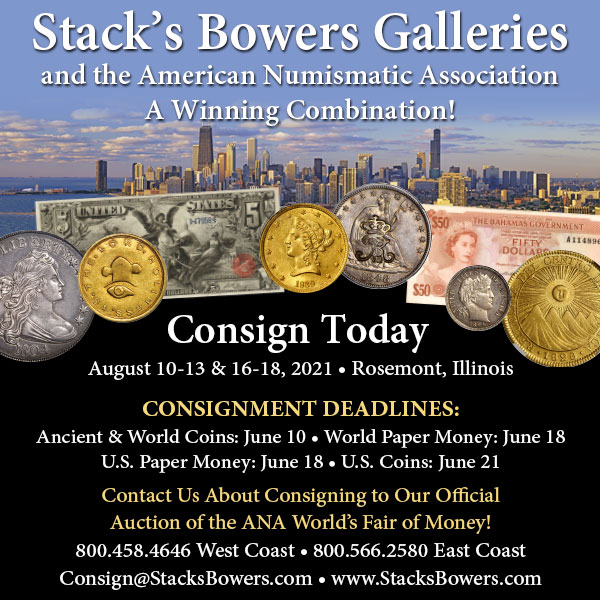
BOOK REVIEW: CONFIDENT CARSON CITY COLLECTOR
Bruce Thayer submitted this review of Rusty Goe's new book. Thanks! -Editor
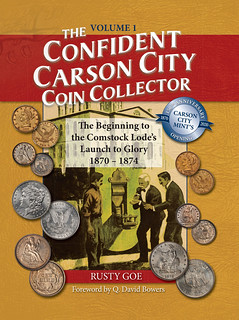 Dear Friends and Carson City coin enthusiasts,
Dear Friends and Carson City coin enthusiasts,
Fifteen years ago, I telephoned a coin dealer in Nevada to enquire about an 1878 CC quarter for sale on the dealer's web site. I was a total numis-novice at the time, and was considering the coin for a US coin type set that I had recently started. The lady answering the phone asked me to wait a moment while she sought someone named “Rusty", who would answer my questions.
Little did I realize that “Rusty", who patiently answered my neophyte questions, was among the world's leading authorities on Carson City coins. That single phone ultimately enriched my life and opened the door to the fascinating subject of Carson City minted coins and their important place in American history.
Over the past 15 years, I have had the honor of working closely with Rusty Goe who has helped me patiently select and acquire every one of the 96 date-denominations (AU-53 Avg) in my collection, utilizing Rusty's extremely high, quality standards, regardless of the grade.
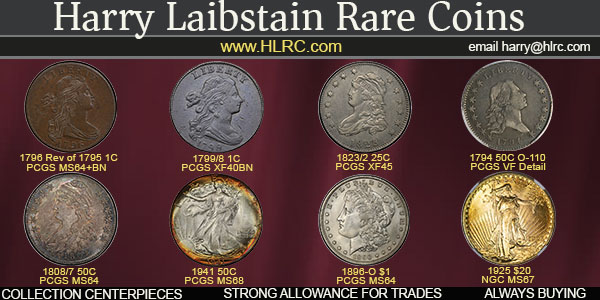
BOOK REVIEW: GUIDE BOOK OF U.S. PAPER MONEY
Mike Thorne published a nice review in Numismatic News of Whitman's sixth edition of A Guide Book of United States Paper Money. I just had my copy of the book out yesterday, and it's a quite useful volume. Here's an excerpt of the review - see the complete article online. -Editor
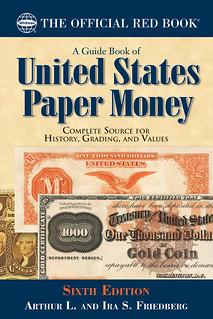 Going through the 6th edition of Whitman's A Guide Book of United States Paper Money, I can begin to see what the fuss over paper money is all about. After all, virtually any 19th century banknote is more attractive than the average coin featuring the same central motif. If you think that the Indian on the Buffalo nickel is strikingly attractive, take a gander at the $5 "Indian Chief Note" featuring the chief colloquially known as Running Antelope. Of course, the Chief has a much larger canvas than the fellow on the nickel. It's that larger canvas that makes the images on banknotes so striking.
Going through the 6th edition of Whitman's A Guide Book of United States Paper Money, I can begin to see what the fuss over paper money is all about. After all, virtually any 19th century banknote is more attractive than the average coin featuring the same central motif. If you think that the Indian on the Buffalo nickel is strikingly attractive, take a gander at the $5 "Indian Chief Note" featuring the chief colloquially known as Running Antelope. Of course, the Chief has a much larger canvas than the fellow on the nickel. It's that larger canvas that makes the images on banknotes so striking.
The authors of this guide book are a pair of brothers, Arthur and Ira Friedberg, who have been in the numismatic business for more than 30 years. Both joined the family business (Coin & Currency) after finishing college. Among other activities, Arthur and Ira have stayed busy co-authoring such popular works as Gold Coins of the World, Paper Money of the United States, and Appraising and Selling Your Coins.

GLENDINING AUCTION SALE CATALOGS ON NNP
The latest additions to the Newman Numismatic Portal are the post-1923 Glendining sale catalogs. Project Coordinator Len Augsburger provided the following report. -Editor
Glendining Auction Sale Catalogs on Newman Portal
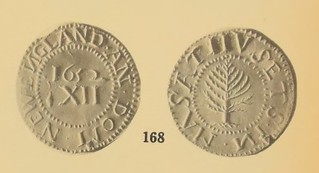 Important American numismatic material frequently shows up in European sales, as demonstrated by a 1935 Glendining's auction sale catalog. This sale included 262 lots of American items including a good variety of federal and colonial pieces. Four plates will support pedigree research of the frontline examples. Newman Portal previously scanned the Glendining's catalog run from 1901-1923 and is now proceeding with the remainder of these UK sales.
Important American numismatic material frequently shows up in European sales, as demonstrated by a 1935 Glendining's auction sale catalog. This sale included 262 lots of American items including a good variety of federal and colonial pieces. Four plates will support pedigree research of the frontline examples. Newman Portal previously scanned the Glendining's catalog run from 1901-1923 and is now proceeding with the remainder of these UK sales.
Thanks to John Millensted of Bonham's (successor to Glendining) for granting permission to scan these catalogs, NNP supporter Eric Hodge for working with Glendining, ANS Librarian David Hill for coordination with Internet Archive, and Lara Jacobs of Internet Archive who performs scanning activities at the ANS library.
Image: Pine Tree Shilling, Crosby 5, lot 168 from the Glendining March 21, 1935 sale
Link to Glendining's 1935 Catalogue of Early American Coins:
https://archive.org/details/catalogueofearly00glen/page/n5/mode/2up
Link to Glendining's auction sale catalogs on Newman Portal:
https://nnp.wustl.edu/library/auctioncompanydetail/512958

VIDEO: PAPER MONEY AT COLLECTORAMA 2021
These are selections from the David Lisot Video Library that feature news and personalities from the world of coin collecting. David has been attending coin conventions since 1972 and began videotaping in 1985. The Newman Numismatic Portal now lists all David's videos on their website at:
https://nnp.wustl.edu/library/multimediadetail/522852
Here's one on paper money seen at Collectorama 2021. -Editor
Cool US and World Currency at Collectorama 2021!
VIDEO: 13:35.
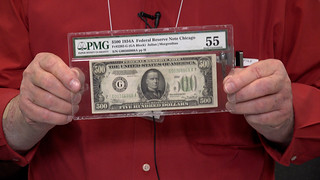 David Lisot, Interviewer, CoinTelevision.com with John Bremer, Robert Calderman and Larry Garvin. February 18, 2021.
David Lisot, Interviewer, CoinTelevision.com with John Bremer, Robert Calderman and Larry Garvin. February 18, 2021.
David Lisot brings paper money to his audience by interviewing paper money experts that show both large and small size notes. Topics range from US to world bank notes including the Legal Tender “Woodchopper" 1869 PMG64, 1878 PMG64, & 1907 PMG64 $5, $500 1934 Legal Tender, 1923 and 1928 Silver Certificate PMG64 , 1928 Federal Reserve Serial #4 PCGS66PPQ, 1928 Federal Reserve PMG64 “Star Note", German East Africa 5 Rupien 1906 PMG40, Russia 100 Kopeks 1910 “Catherine the Great", British Caribbean Territories $1 Queen Elizabeth 1963 PMG45, and Chinese reproductions from 1950's.
An excerpt of the video is available for viewing on the Coin Television YouTube Channel at:
https://www.youtube.com/watch?v=okvyv8xp3bI
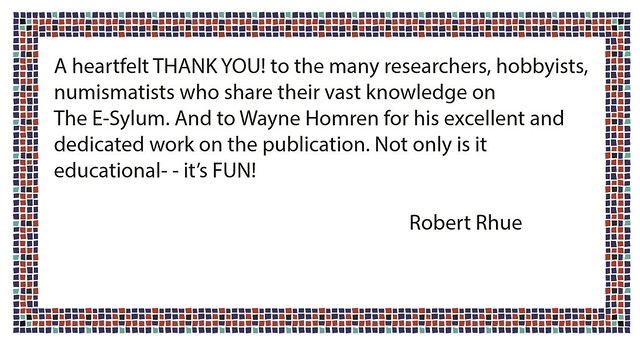
THE MYSTERIOUS WHITEHEAD & HOAG TOKEN
Readers commented on the odd Whitehead & Hoag token Len Augsburger asked about last week. -Editor
Joel Anderson writes:
"I had similar pieces in a collection of Magician's tokens that I handled about 25 or 30 years ago. Alas, I do not recall any of the details. Some of the pieces in the collection had nonsensical legends in order to make them look exotic. Someone might explore magician token references."

MORE ON DIE VARIETIES
Regarding his question about the definition of coin varieties, Bill Eckberg wrote:

WARREN & SON, SACRAMENTO
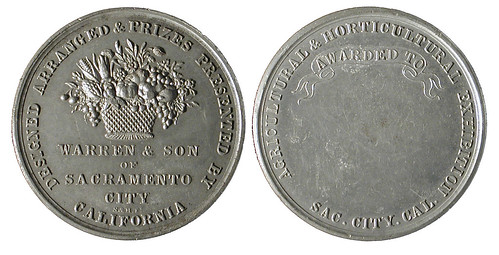

NOTES FROM E-SYLUM READERS: APRIL 18, 2021
Clifford Mishler on Meeting Prince PhilipClifford Mishler writes:
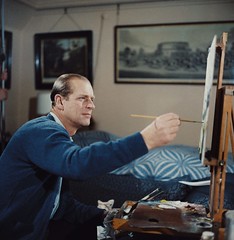 "Reading your ‘numismatic connection" reference to Prince Philip as “president of the Royal Mint Advisory Committee," I thought I might share another related sidelight.
"Reading your ‘numismatic connection" reference to Prince Philip as “president of the Royal Mint Advisory Committee," I thought I might share another related sidelight.
"In 1996 I was accorded the favor of having the opportunity of shaking hands and briefly chatting with Prince Philip when I visited London for the purpose of presenting the British Royal Mint and the United Kingdom with the “Coin of The Year" recognition of their being honored as the producer of the premiere 1994 COTY winner, the “50th Anniversary of the Invasion of Normandy" 50 pence commemorative, which was the work of one of England's most talented sculptors, John Mills. Displayed on my office wall is a sketch of that winning design, which was tendered to me at the time by Mr. Mills."
Marvelous - what a great experience. -Editor
To read the earlier E-Sylum article, see:
NOTES FROM E-SYLUM READERS: APRIL 11, 2021 : Prince Philip, Royal Mint Advisor : 2017 Prince Philip Coin
(https://www.coinbooks.org/v24/esylum_v24n15a14.html)
Other topics this week include J.N.T. Levick's Civil War Tokens, and the Seated Liberty design. -Editor
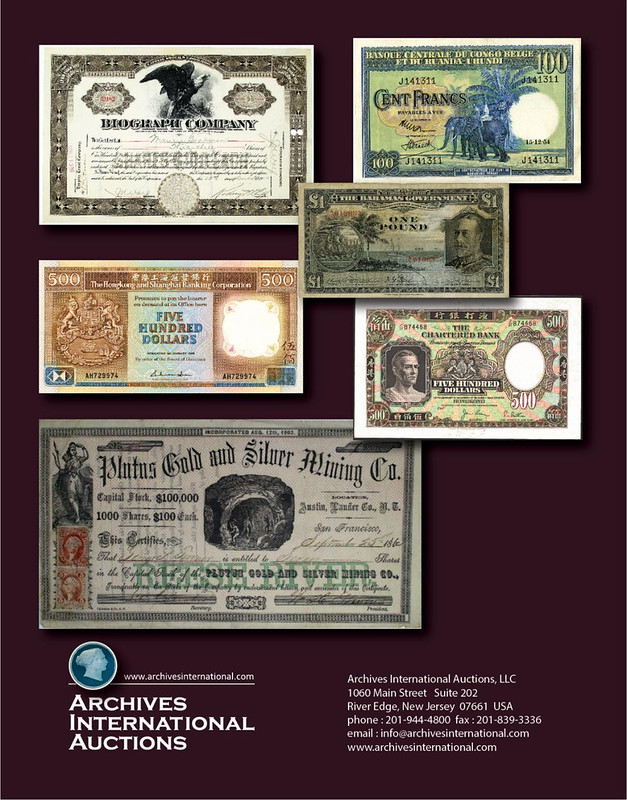
VOCABULARY TERM: DIE STAMPED, DIE STRUCK
Here's another entry from Dick Johnson's Encyclopedia of Coin and Medal Terminology. -Editor
Die Stamped, Die Struck. Striking a blank of metal with two punches (dies) under pressure and at room temperature. Die stamped or die struck is in contrast to any other metalworking methods of manufacture, as cast, hammered, rolled, forged, or even die-cast. Striking with dies is the traditional method of manufacturing coins and medals since the mid 16th century. Die striking is also called coining (and the piece is coined) when there are two relative flat surfaces with no deep drawing of the surface metal.
Die striking (coining) creates the sharp impression in hard metal suitable for coins, medals, tokens and the similar items discussed in this book. Not all metals are suitable for the blanks for coining (see coinability), however only one metal is suitable for the manufacture of the dies required – they must be made of steel. As coinage technology evolved the method of applying the pressure, by coining presses, has changed. But the end product – coins to circulate – have changed little for centuries (other than design, of course). Although an attempt has been tried twice in history to manufacture coins by roller dies and blanking afterwards (taschenwerke), this process failed both times. In effect, no new basic method of manufacture has been invented to replace die stamping or die striking of preformed blanks. This method is a 400-year old successful technology that appears to continue well into the future.
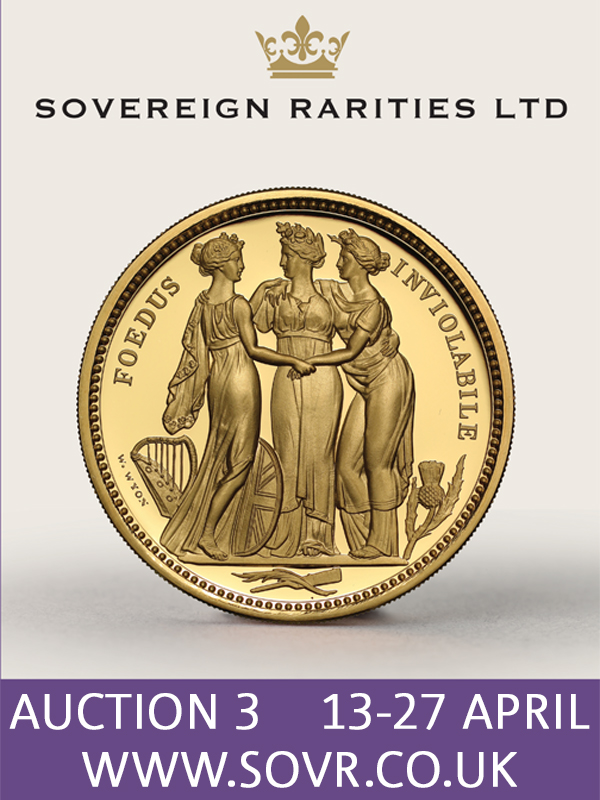
JOHN HENRY MATTHEWS (1808-1870)
Here's another entry from the online draft of John Lupia's book of numismatic biographies. Thanks! This is an excerpt with the full article and bibliography available online. This week's subject is Soda Fountain King John Matthews. -Editor
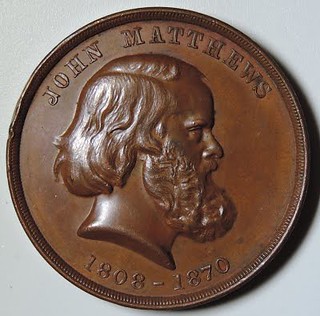 John Henry Matthews (1808-1870), was born on December 19, 1808, at Standford, Dingley, Berkshire, England, the son of John Matthews (-1827), and Elizabeth Robinson Matthews (1786-1846).
John Henry Matthews (1808-1870), was born on December 19, 1808, at Standford, Dingley, Berkshire, England, the son of John Matthews (-1827), and Elizabeth Robinson Matthews (1786-1846).
On February 8, 1830, he married Elizabeth Chester (1811-1889) at Bristol, England. They had six children : two daughters and four sons.
On March 2, 1832, he moved to New York City, New York.
In 1832, he designed, patented and issued the soda water fountain.
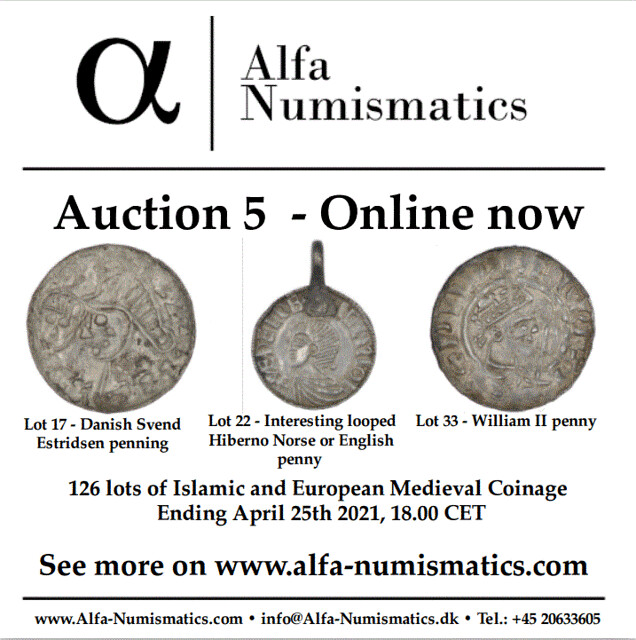
B. MAX MEHL, FORT WORTH MARKETING WHIZ
The Fort Worth Star-Telegram published a nice article about native son B. Max Mehl, one of the largest coin dealers of the 20th century. -Editor
B. Max Mehl, an immigrant lad who clerked in a shoe store for 25 cents a week, made a fortune from small change. When customers paid, he examined their cash for rare pennies, nickels, dimes and half dollars.
In 1903, he placed an ad in The Numismatist, a coin collecting magazine, and sold his vintage coins to the highest bidders. A year later he ran classified ads in the Fort Worth Telegram. In 1906 he held a coin auction by mail and promoted his business with five lines in Colliers magazine, becoming the first coin dealer to advertise in the popular press. Within a decade, Mehl had turned coin collecting into a hobby for the masses.

NEW NLG EXECUTIVE DIRECTOR CHARLES MORGAN
The Numismatic Literary Guild has a new Executive Director. Here's the press release. -Editor
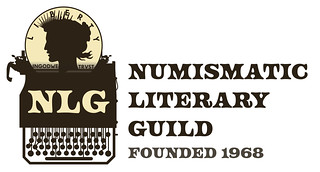 The Numismatic Literary Guild (www.NLGonline.org) has selected Charles Morgan, editor-in-chief of CoinWeek (www.CoinWeek.com), to be the organization's next Executive Director. He succeeds numismatic researcher, author, and dealer Ron Guth who served in the post for three years.
The Numismatic Literary Guild (www.NLGonline.org) has selected Charles Morgan, editor-in-chief of CoinWeek (www.CoinWeek.com), to be the organization's next Executive Director. He succeeds numismatic researcher, author, and dealer Ron Guth who served in the post for three years.
The NLG is a nonprofit organization composed of more than 200 editors, authors, writers, bloggers, and club newsletter editors as well as online content and audio and video producers. Membership is open to anyone, professional or amateur, who covers news and feature stories about all forms of money, medals, and tokens as collectibles. Membership dues are $15 a year. Information about joining is available online at www.NLGonline.org/membership.

THE NUMISMATIC LITERARY GUILD MISSION
The Numismatic Literary Guild (NLG) is a separate organization from the Numismatic Bibliomania Society (NBS). It's an industry group for today's numismatic authors and publishers. NBS is a collector organization for anyone with an interest in numismatic literature and research of all eras. There is a natural overlap in our membership, with many individuals card-carrying members of both organizations.
NLG publishes a monthly newsletter for its members. Issues contain guest articles from NLG members focused on writing about coins, plus reading recommendations concerning current projects published by members. You can only receive this if you are a member. Dues are only $15 annually. Executive Director Charles Morgan notes that "the NLG is focused on building a year-round community to foster better working relationships between writers in our field."
With permission, here's an excerpt from the latest issue ( Vol. 63, Issue 1, April 2021) exploring the group's history. -Editor
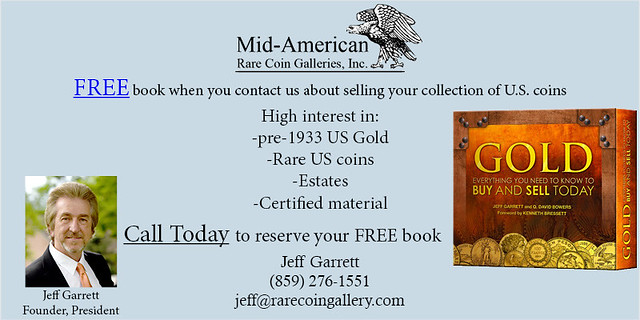
ICTA REBRANDS AS NATIONAL COIN & BULLION
Another numismatic industry group is undergoing a change - the Industry Council for Tangible Assets (ICTA) is changing its name and branding to better reflect its mission. Here's the press release. -Editor
Introducing ICTA New Brand Identity
Big news! Today, after 36 years, we are releasing a new brand identity, which includes a new name, logo, and website.
The time has come to specify the mission of the Industry Council for Tangible Assets in our branding, including our name and logo. We do not represent the broad range of collectible tangible assets that our name implies, which could include anything from antiques to postage stamps to memorabilia to fine wines, and much more.

MPC FEST XXII/2021 REPORT
MPC Gram is a newsletter for collectors of Military Payment Certificates and other military numismatica. The yearly MPC fest is an annual gathering of readers organized by editor Fred Schwan and avid contributors and readers. For the second year in a row the Fest was conducted online due to the COVID-19 pandemic. Here is the post-Fest press release, compiled and submitted by Helen-Louise Boling, public information officer. -Editor
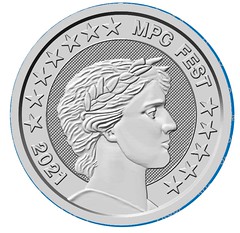 Fest XXII/2021 is now in the history books, and it is time to honor those honored for their work in this specialized field of numismatics. We are pleased to announce honorees in four categories.
Fest XXII/2021 is now in the history books, and it is time to honor those honored for their work in this specialized field of numismatics. We are pleased to announce honorees in four categories.
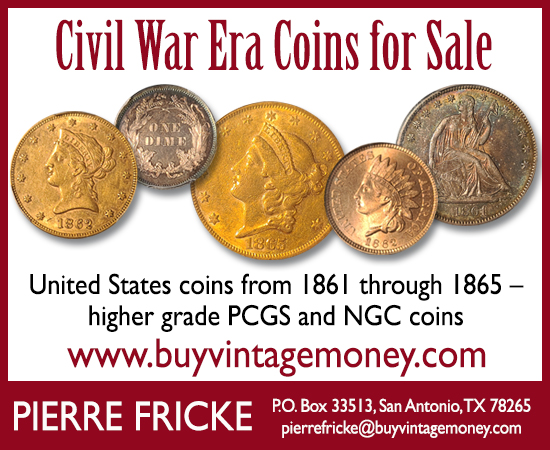
ARCHIVES INTERNATIONAL AUCTION 66
Here is the announcement for the April 23, 2021 sale by Archives International Auctions. -Editor
ARCHIVES INTERNATIONAL AUCTIONS OFFERS RARE CHINESE, AND WORLD BANKNOTES AND SCRIPOPHILY ALONG WITH HUNDREDS OF BONDS AND SHARES AT ITS APRIL 23rd, 2021 PUBLIC AUCTION IN RIVER EDGE, NEW JERSEY
The auction will be held by Archives International Auctions at their offices in River Edge, N.J.
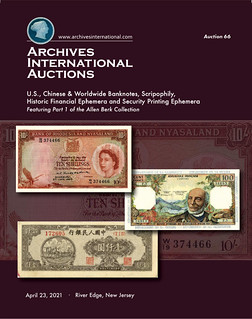 The April 23rd, 2021 auction, held in 3 sessions, by Archives International Auctions is highlighted by the Allen Berk World Banknote Collection featuring hundreds of exceptional world banknotes, many having never been offered previously at auction or having been off the collecting market for decades. Allen, as an artist as well as world traveler, had a discerning and amazing eye for beauty, condition and rarity in his collecting pursuits which is evident in the banknotes offered in this and subsequent auctions. In addition to selections from the Allen Berk Collection, there are over 200 lots of Chinese, Hong Kong and Asian banknotes in the first part of the auction. Many of the notes are in exceptional if not the highest known condition with many rarities present.
The April 23rd, 2021 auction, held in 3 sessions, by Archives International Auctions is highlighted by the Allen Berk World Banknote Collection featuring hundreds of exceptional world banknotes, many having never been offered previously at auction or having been off the collecting market for decades. Allen, as an artist as well as world traveler, had a discerning and amazing eye for beauty, condition and rarity in his collecting pursuits which is evident in the banknotes offered in this and subsequent auctions. In addition to selections from the Allen Berk Collection, there are over 200 lots of Chinese, Hong Kong and Asian banknotes in the first part of the auction. Many of the notes are in exceptional if not the highest known condition with many rarities present.
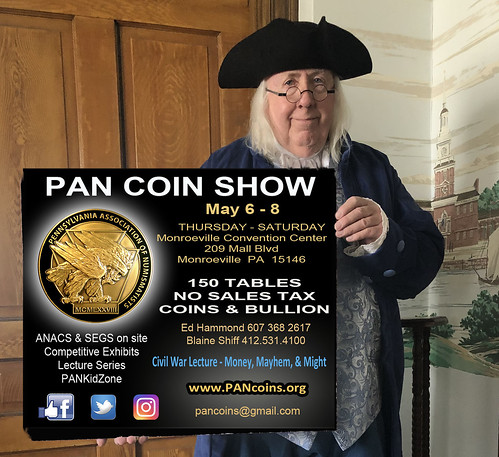
SOVEREIGN RARITIES LONDON AUCTION 3
Here's the announcement for the latest Sovereign Rarities sale. -Editor
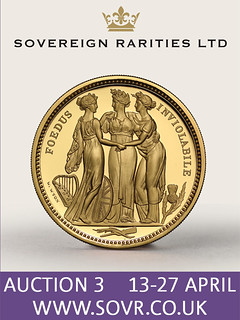 Sovereign Rarities are pleased to hold their third auction on the 27th April 2021, their first London-based sale since September 2019. The pre-bidding phase is open now at
www.sovr.co.uk until the live auction on the day, and we hope the sale contains something for everyone with coins from ancient to modern.
Sovereign Rarities are pleased to hold their third auction on the 27th April 2021, their first London-based sale since September 2019. The pre-bidding phase is open now at
www.sovr.co.uk until the live auction on the day, and we hope the sale contains something for everyone with coins from ancient to modern.
The sale begins with eight lots of ancient Greek and Roman coins, one nicely struck piece being an Augustus Denarius (lot 6, £1,500-2,000) with the standing bull on the reverse.
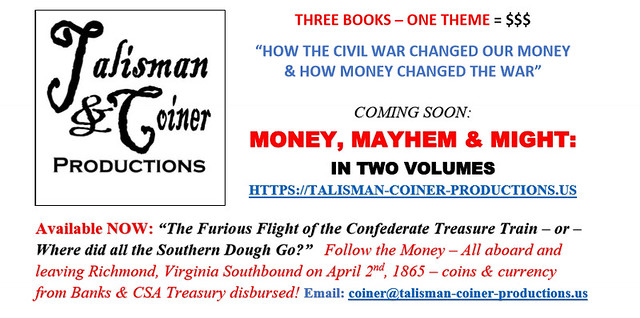
NUMISMATIC NUGGETS: APRIL 18, 2021
Here's a selection of interesting or unusual items I came across in the marketplace this week. Tell us what you think of some of these. -Editor
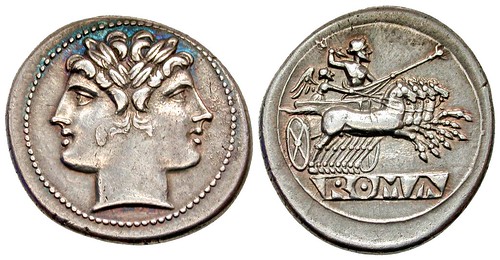
Anonymous. Ca. 225-214/212 B.C. AR quadrigatus (24.5 mm, 6.67 g, 7 h). Rome mint. Laureate janiform head / Jupiter, holding scepter in his left hand and hurling his thunderbolt from his right, standing right in a quadriga, driven to the right by Victory who stands beside him; below, tablet inscribed with ROMA in incuse letters. Crawford 29/3; Sydenham 64A. Nice EF. Spectacular.
From Agora Auctions May 2021 sale. -Editor
To read the complete lot description, see:
Lot 144. Anonymous. Ca. 225-214/212 B.C. AR quadrigatus. Rome mint. Spectacular. From the Trausnitz Collection, ex Lanz 68, 6 June 1994, 280.
(https://agoraauctions.com/listing/viewdetail/51138)
Other topics this week include a curved counterstamp, and Algeria brothel token, and a gold Westminster Abbey medal. -Editor
LORD ST. OSWALD 1794 HALF CENT REAPPEARS
Ron Guth published a blog article about the Lord St. Oswald 1794 Half Cent. Here's an excerpt - see the complete article online. -Editor
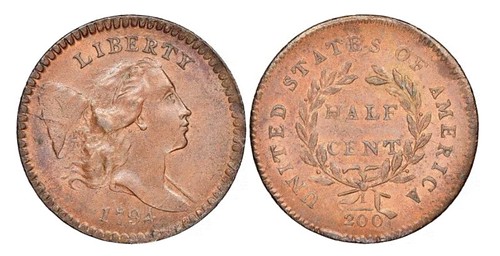
In 1795, an Englishman named William Strickland returned to his home following a sight-seeing trip to America that began in 1794. On his voyage home, Strickland carried with him two 1794 Half Cents, a 1793 Chain Cent, twenty-four 1794 Large Cents, three 1795 Half Dollars, two 1794 Silver Dollars, three 1795 Silver Dollars, and a mixed lot of Colonial coins. Most of the coins he acquired were in what we would call “Mint State" today and many represent the finest examples of their type known to exist. The total face value of his thirty-five coins was a mere $6.76 but, today, that small handful of coins is worth millions of dollars.

2021 AMSA MEDAL OF THE YEAR WINNERS
Congratulations to Jeanne Stevens-Sollman for winning the 2021 American Medallic Sculptors Association Medal Of the Year award. Here's the press release. -Editor
the 2021 American Medal of the Year (AMY) Award
The American Medallic Sculptors Association (AMSA) has announced that Jeanne Stevens-Sollman has won the 2021 American Medal of the Year (AMY) award for her powerful work honoring George Floyd.
Following the tragic shootings of Anton Rose, Ahmaud Arbery, Elijah McClain, Breanna Taylor and other Blacks, when George Floyd's life was snuffed out by a white police officer in May, 2020, Jeanne Stevens-Sollman was overwhelmed, asking herself “Why? What can I do??"

2020 IBNS BANK NOTE OF YEAR AWARD
Kavan Ratnatungas passed along the press release for the IBNS Bank Note of Year Award. Thanks! -Editor
The International Bank Note Society (IBNS) announces that its voting membership has selected the Banco de Mexico to receive its annual prestigious “Bank Note of the Year Award" for 2020. With well over 100 new banknotes released worldwide during 2020, only 24 were deemed of sufficiently new design to be member nominated. Almost from the start, Mexico's new 100 Peso polymer bill widely led the voting followed by Scotland's Bank of Scotland 20 Pound entry (Kate Cranston tea room/squirrels). There was a virtual tie for third place between Northern Ireland's Ulster Bank (20 Pound flora/street musicians), the Bahamas (5 Dollar statesman/junkanoo dancer) and Fiji (50 Dollar 50th Anniversary of Independence). Rounding out the top seven vote getters were the Bank of England (20 Pound Queen/J.M.W. Turner with painting) and Scotland's Clydesdale Bank (20 Pound Robert the Bruce/St. Kilda).
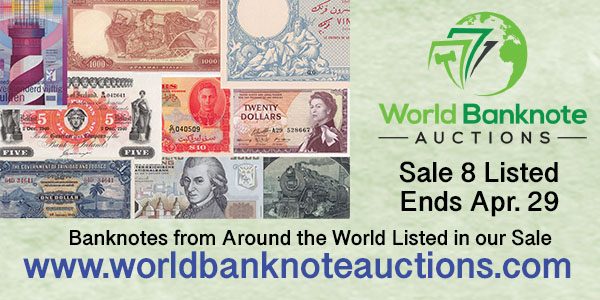
MAGNET FISHERS FIND SAFE WITH STOLEN COINS
Roger Siboni and Leon Saryan passed along this Newsweek article about a submerged safe filled with stolen coins. Thanks. I'd never heard of "magnet fishing", but I guess it can be fun. -Editor
Aself-proclaimed treasure hunter struck gold when he found a submerged safe filled with stolen coins.
Leigh Webber, who goes by Bondi Treasure Hunter online, shared a video to TikTok recounting a memorable find in an Amsterdam canal.
Leigh, originally from Australia, was magnet fishing when he and some friends came across a stretch of water with more than 46 safes buried in the riverbed.

OLD BUILDING YIELDS GOLD HOARD
Leon Saryan and Arthur Shippee passed along this article about a fortunate find in a house in France. -Editor
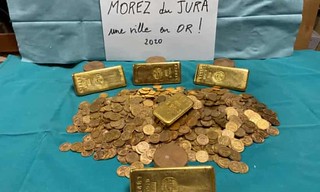 The surprise discovery of three jam jars filled with gold bars and hundreds of gold coins in an old building marked for renovation has left a mountain community in eastern France perplexed and celebrating.
The surprise discovery of three jam jars filled with gold bars and hundreds of gold coins in an old building marked for renovation has left a mountain community in eastern France perplexed and celebrating.
The mayor of Morez, a small industrial town in a picturesque valley in the Jura, said the value of the find was more than €600,000 (£520,000). Town hall staff first found three jam jars of gold bars and coins worth €500,000 at the back of a dusty shelf, then opened a safe hidden behind boxes in a wardrobe to find up to €150,000 in gold coins.
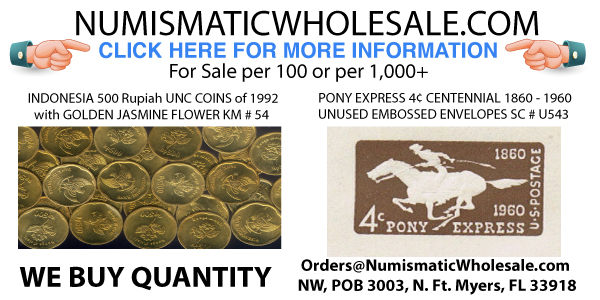
LOOSE CHANGE: APRIL 18, 2021
Here are some additional items in the media this week that may be of interest. -Editor
Michael Shutterly published a nice CoinWeek article on building an ancient coin exhibit. -Editor
I put on my first numismatic exhibit at the ANA World's Fair of Money in Chicago in 2015. I was pleased with the results; Sacred Images won the awards for “Best Exhibit by a First Time Exhibitor" and “First Place – Coins Before 1500."
At the ANA Awards Banquet, I found myself seated next to Larry Sekulich, who told me that he did not think that I had put on a good exhibit – he said that I had put on at least three good exhibits. My exhibit included 61 different coins covering a wide array of sub-topics, and Larry suggested that I should consider bringing more focus to my presentations.
I figured that Larry probably knew what he was talking about. Not only had he won that year's “Howland Wood Memorial Award for Best-of-Show Exhibit" (his third win of that award), but he is also the instructor for the ANA's Summer Seminar class “Creating a Winning Numismatic Exhibit".
To read the complete article, see:
The One That Got Away: The Trials and Tribulations of Building an Ancient Coin Exhibit
(https://coinweek.com/ancient-coins/the-one-that-got-away-the-trials-and-tribulations-of-building-an-ancient-coin-exhibit/)
Other topics this week include Vartan Gregorian. -Editor


